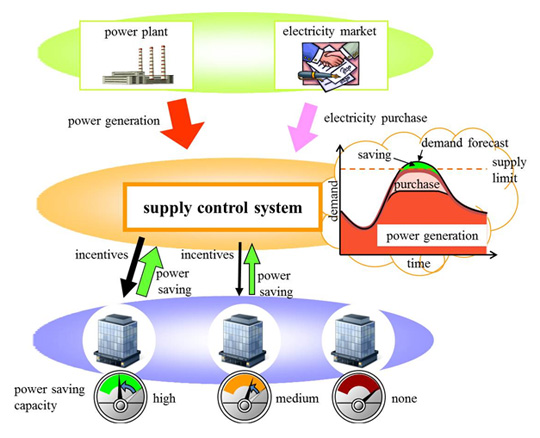News Release Archives
Note that the releases are accurate at the time of publication but may be subject to change without notice.
FOR IMMEDIATE RELEASE No. 2731
Mitsubishi Electric Develops Energy Management System with Demand-response Capability
Stabilizes power supply & demand management while minimizing electricity costs
TOKYO, February 14, 2013 - Mitsubishi Electric Corporation (TOKYO: 6503) announced today that it has developed the technology for an energy management system (EMS) that responds dynamically to supply-demand conditions. The system automatically evaluates fluctuating power-generation costs and electricity-market prices to determine optimized incentives for saving power, thereby helping to stabilize supply and demand management while minimizing costs and benefits for utilities and customers alike. The technology was achieved through the company's Smart Grid Demonstration Project initiative.


To help decrease power consumption during times of peak demand, power utilities have been widely implementing demand-response schemes that offer incentives to customers in exchange for their curtailed use of power. However, conventional demand-response schemes only offer the same fixed incentives to all customers, which can result either insufficient or excessive power savings depending on the conditions.

Key Technologies

Mitsubishi Electric's newly developed technology vs. conventional systems

Pending patents for the technology announced in this news release number four in Japan.
Key Technologies
| 1) | Power savings tailored to each user depending on capacity to curtail power usage
|
|
| 2) | Optimized incentives reflecting power-generation costs and electricity-market prices
|
|
| 3) | Lower power-supply costs through minimized installation of electrical facilities
|
|
Mitsubishi Electric's newly developed technology vs. conventional systems
| Function | Performance | |
| EMS with demand-response | Optimized incentives reflecting fluctuating power generation costs and market prices. | Incentives for utilities and customers, and benefits during periods of peak demand and excess supply. |
| Conventional | Fixed, uniform incentives for all customers by contract. | Possibility of unstable demand management because incentives are not optimized. |
Pending patents for the technology announced in this news release number four in Japan.